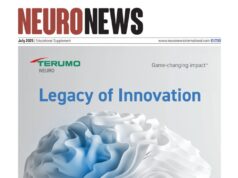
Microvention, a wholly owned subsidiary of Terumo Corporation, announced today that the LVIS EVO intraluminal support device is now commercially available for the treatment of wide-neck intracranial aneurysms in the USA.
“I’ve really enjoyed getting to use and know EVO,” said Charles Matouk (Yale University, New Haven, USA). “With improved visibility and the ability to shelf the stent across the aneurysm neck, it’s become my tool of choice for stent-assisted coiling.”
A company press release describes LVIS EVO as the “next evolution” in stent innovation, and notes that the device has been available in Europe since 2019 with more than 12,000 units having been sold.
LVIS EVO is the first fully visible coil-assist intracranial stent available in the US market, delivering enhanced visualisation, optimised opening and precise placement with drawn filled tube (DFT) wire construction, and advanced braid design, the release adds.
With enhanced visualisation, the device provides wall apposition confirmation, as the entire body of the stent is fully visible under fluoroscopy. Its optimised braid angle allows for improved device opening along the entire length of the device. And, with precise placement, LVIS EVO offers controlled delivery and development, as well as the ability to resheath it up to 80% of the device length.
According to Microvention, the entire LVIS EVO portfolio is compatible with the company’s Headway 17 advanced microcatheter, and Scepter C and Scepter XC occlusion balloons.
“Today’s announcement underscores Microvention’s commitment to delivering groundbreaking solutions for haemorrhagic stroke treatment,” said Carsten Schroeder, president and chief executive officer of Microvention. “Microvention continues to lead the way in both haemorrhagic and ischaemic stroke care. This achievement is a testament to our collaboration with leading physicians worldwide. By identifying the evolving needs in patient care and transforming those insights into innovative technologies, we are able to save lives and improve outcomes.”









